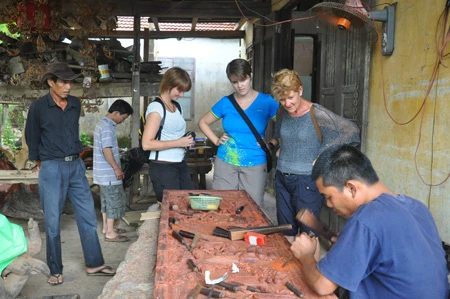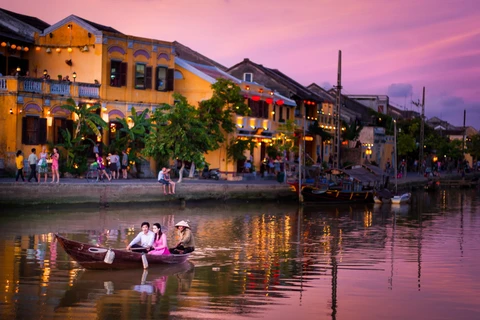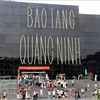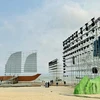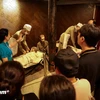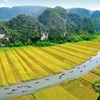Quang Nam (VNS/VNA) - The picture that comes to mind when thinking of Hoi An is of magical multi-coloured lanterns lighting up the meandering Hoai River, the town’s signature yellow-painted old houses or the little charming cafés and shops in the old town.
Cam Kim commune on the town’s outskirts is near, yet another world. Separated from the old town by the Thu Bon River, this peaceful village can be reached by boat or a ten-minute bike ride.
One of the commune’s tourist highlights is Kim Bong village, known for its unique religious rituals as well as its carpentry, which was recognised as a national intangible cultural heritage last year.
A stroll or bike ride through the tiny village, only about 40ha in size, reveals greenish rice fields, colourful fruit and flower gardens and local women sitting at their weaving machines.
Kim Bong village of Cam Kim commune is one of the earliest Hoi An villages, to which the carpentry craft was brought in the 15th century from the north and central regions of Nghe An and Thanh Hoa.
Cam Kim commune on the town’s outskirts is near, yet another world. Separated from the old town by the Thu Bon River, this peaceful village can be reached by boat or a ten-minute bike ride.
One of the commune’s tourist highlights is Kim Bong village, known for its unique religious rituals as well as its carpentry, which was recognised as a national intangible cultural heritage last year.
A stroll or bike ride through the tiny village, only about 40ha in size, reveals greenish rice fields, colourful fruit and flower gardens and local women sitting at their weaving machines.
Kim Bong village of Cam Kim commune is one of the earliest Hoi An villages, to which the carpentry craft was brought in the 15th century from the north and central regions of Nghe An and Thanh Hoa.
The sounds of carpentry are indeed unmistakable as soon as one steps foot in Kim Bong village.
The drilling, chiseling and cutting echoe from households, where one can also see delicate carvings of the artisans and hear the history of local carpentry.
In late 17th century, Hoi An was a busy and important port, trading with local and foreign cities and paving the way for craft villages like Thanh Ha (pottery) and Kim Bong to develop and prosper.
At the time, Kim Bong served the needs of urban architecture, making family furniture and boats as well as the decorative, characteristic carpentry of Hoi An.
Kim Bong carpentry products have since not only contributed to the architecture of Hoi An’s old town, they have also been used in several monuments in the cities of Da Nang and Hue.
These days visitors to Kim Bong can visit the eastern part of the village where boats are made, and the western part, which makes carpentry carvings. One can also see the village carpentry products in old town shops.
While carpentry of other localities is greatly influenced by northern culture, with characteristics of feudal times with symbolic patterns or powerful creatures like dragon, Kim Bong’s wooden products appear influenced more by nature, with carvings of trees or flowers.
The Hoi An Department of Trade and Tourism recently introduced a Kim Bong tour, giving travellers a chance to experience the cultural and religious activities of the traditional craft village.
The tour features destinations such as Ms Quan’s banh trang (a traditional Vietnamese dish known as "girdle pancakes"), the Huynh Ri ancient house, and the Anh Vu ecological tourism area, and offers the experience of traditional folk games and the viewing of traditional craft production. The ritual commemorating the founders of carpentry in Cam Kim is a particularly unique and interesting practice.
Invariably, with tourism comes change. Kim Bong now has carpentry production factories, a guest reception centre, and a centre introducing and promoting tours, such as a "Being a Kim Bong Artisan" tour. Four homestays are also available.
Since 2015, Hoi An city has focused on improving tourism activities in its craft villages. The city will open several sites to tourists after restoring characteristic traditional crafts like ship building and repair, mat weaving and carpentry, according to Deputy Director of Hoi An’s Department of Tourism and Trading Nguyen Hung Linh.-VNA
The drilling, chiseling and cutting echoe from households, where one can also see delicate carvings of the artisans and hear the history of local carpentry.
In late 17th century, Hoi An was a busy and important port, trading with local and foreign cities and paving the way for craft villages like Thanh Ha (pottery) and Kim Bong to develop and prosper.
At the time, Kim Bong served the needs of urban architecture, making family furniture and boats as well as the decorative, characteristic carpentry of Hoi An.
Kim Bong carpentry products have since not only contributed to the architecture of Hoi An’s old town, they have also been used in several monuments in the cities of Da Nang and Hue.
These days visitors to Kim Bong can visit the eastern part of the village where boats are made, and the western part, which makes carpentry carvings. One can also see the village carpentry products in old town shops.
While carpentry of other localities is greatly influenced by northern culture, with characteristics of feudal times with symbolic patterns or powerful creatures like dragon, Kim Bong’s wooden products appear influenced more by nature, with carvings of trees or flowers.
The Hoi An Department of Trade and Tourism recently introduced a Kim Bong tour, giving travellers a chance to experience the cultural and religious activities of the traditional craft village.
The tour features destinations such as Ms Quan’s banh trang (a traditional Vietnamese dish known as "girdle pancakes"), the Huynh Ri ancient house, and the Anh Vu ecological tourism area, and offers the experience of traditional folk games and the viewing of traditional craft production. The ritual commemorating the founders of carpentry in Cam Kim is a particularly unique and interesting practice.
Invariably, with tourism comes change. Kim Bong now has carpentry production factories, a guest reception centre, and a centre introducing and promoting tours, such as a "Being a Kim Bong Artisan" tour. Four homestays are also available.
Since 2015, Hoi An city has focused on improving tourism activities in its craft villages. The city will open several sites to tourists after restoring characteristic traditional crafts like ship building and repair, mat weaving and carpentry, according to Deputy Director of Hoi An’s Department of Tourism and Trading Nguyen Hung Linh.-VNA
VNA

